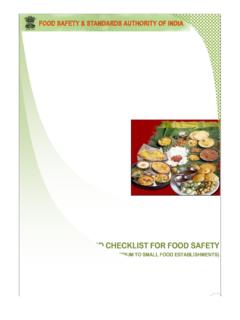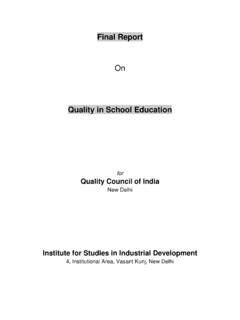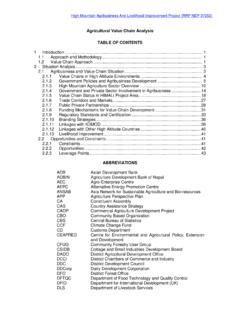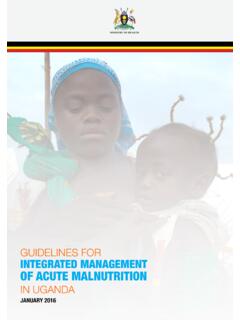Transcription of GOOD AGRICULTURAL PRACTICES – BASIC REQUIREMENTS
1 - 1 - DOC:FSSAI-BASICGAP (FD) good AGRICULTURAL PRACTICES BASIC REQUIREMENTS 0. FOREWORD Agriculture is the mainstay of Indian economy. India s BASIC strength lies in agriculture. But its vast potential has not been fully exploited. While World Trade Organization (WTO) poses some challenges, it also offers tremendous worldwide market opportunities for Indian agriculture produce.
2 This market potential can be realized by reforming agriculture and making its produce internationally competitive in quality and food safety. To enable farm produce to be internationally competitive innovative farming PRACTICES incorporating the concept of globally accepted good AGRICULTURAL PRACTICES (GAP) within the framework of commercial AGRICULTURAL production for long term improvement and sustainability is essential. GAP in addition to improving the yield and quality of the products, also has environmental and social dimensions. Implementation of GAP would promote optimum utilization of resources such as pesticides, fertilizers, and water and eco-friendly agriculture.
3 Its social dimension would be to protect the AGRICULTURAL workers health from improper use of chemicals and pesticides. It is a particularly opportune time to promote GAP when second generation of reforms in agriculture which would have a major impact on Indian agriculture, are planned by the Indian Government. There are different systems and standards available for control measures in value addition through processing of food meant for human consumption. Although grade standards on size, shape, colour and local preferences are available for most of the fruits and vegetables marketed and consumed in India, their quality in terms of maturity standards, residues of pesticides and other contaminants, microbial loads, etc.
4 Have not been adequately addressed. The Indian good AGRICULTURAL PRACTICES (INDGAP) takes into account not only the quality and quantity of the produce obtained from a unit area but also the care is taken in integrating pre-harvest PRACTICES like soil & water management , nutrient management and pest management , harvesting, post harvest handling and other logistics. It is therefore necessary to have a comprehensive view while defining control and compliance systems for different farm produce covering horticulture, floriculture, food grains, etc. The areas where appropriate control measures need to be strengthened are farms producing raw material such as food grains, fresh fruits and vegetables, floriculture, etc.
5 To ensure sustained supply of produce of the desirable quality. With the opening up of the world market, there is a flow of trade in these AGRICULTURAL products. It is, therefore, necessary to define certain minimum standards with a well-defined certification and accreditation mechanism for the implementation of INDGAP to facilitate national and international trade in farm produce. Implementation of INDGAP is voluntary and non-discriminatory to the growers. For the purposes of preparing this document, Global GAP standards and related ISO standards and guides have been taken into consideration. 1. SCOPE This standard covers good AGRICULTURAL PRACTICES (GAP)- BASIC REQUIREMENTS for all farming PRACTICES in sustainable manner for maintaining quality and food safety of AGRICULTURAL produce.
6 2. DEFINITIONS For common understanding by the stakeholder in uniform manner, applicable terms have been defined and are given in Annex A 3. REQUIREMENTS The requirement for good AGRICULTURAL PRACTICES on different aspects from site selection to packaging storage and dispatch of produce for processing are given in Table 01. 4. APPRAISALS AND ASSESMENT REQUIREMENTS stated in Table 01 shall be evaluated to establish that growers comply with those REQUIREMENTS . An appraisal and assessment system has been developed. On evaluation of deficiencies that may appear in evaluation need to be resolved to establish compliance to the REQUIREMENTS . These deficiencies have been classified as: Critical: When evidence shows that the grower has not complied with REQUIREMENTS in its documentation and implementation and which raises doubts on the operation and practice of GAP calling for an early correction and corrective actions within the time frame.
7 Major: When evidence suggests major break down in the implementation in certain elements of the criteria calling for the early corrective actions within a time frame 3 Minor: When evidence shows an isolated non-compliance to the GAP criteria and has negligible impact on the operation of the system and its results. Note: Multiple Minor NCs with related impact on the operation of the system in one particular area may result in major NC To develop a self assessment method against the criteria, a checklist has been developed and is given in Table 02. This will bring uniformity in evaluation of the system. This also indicates when a violation of a particular criteria leads to critical, major or minor nonconformities.
8 4 TABLE 01 REQUIREMENTS AND EVALUATION CRITERIA Clauses Item Level of compliance Control criteria Compliance criteria 1 SITE SELECTION (One of the key features of sustainable farming is the continuous integration of site-specific knowledge and practical experiences into future management planning and PRACTICES .) Risk assessment for new site Major Is site free from toxic elements such as industrial wastes and effluents? The information on soil condition and site on water logging, industrial waste and effluents Water availability Major Is the site having access to reliable source of irrigation water (where applicable/relevant)? There should be sufficient source of irrigation water. Risk management plan Major Has a management plan been developed setting out strategies to minimize all identified risks?
9 Are the results of this analysis recorded and used to justify that the site in question is suitable? A management plan for mitigation of risk should be implemented to meet the objectives Meteorological data collection Minor Has the meteorological data collated for preceding three years taken into account while judging the suitability of the site. Three years meteorological data should be available with the farm management 2 SOIL CONDITIONS/ management (Soil is the basis of all AGRICULTURAL production, and the conservation and improvement of this valuable resource is essential. good soil husbandry ensures long-term fertility of soil, aids yield and profitability.) Mapping of Soil Major Has the soil map prepared for the farm The type of soil is identified for each site, based on a soil profile or soil analysis.
10 Soil Health Major Is the soil optimal to the selected crop with reference to its water holding capacity and fertility? Data on physico-chemical properties of soil-texture and structure be available Soil test and nutrition profile Major If soils with low fertility levels use soil amendments as per the specific site and requirement of species, are the latest soil test report on physico-chemical parameters and nutrient profile to decide the nature and quantity of soil amendments available? The soil analysis report from an independent lab should be available. Technical expertise for the quantity, quality and type of soil amendments to be used Water suitability Major Has the quality of irrigation water been adequately understood and classified in the context of both soil type and the target crop in terms of total salt concentration, Sodium absorption ratio, Bicarbonate and Boron concentration etc.






